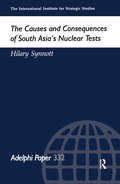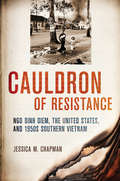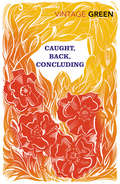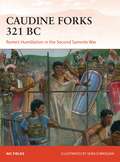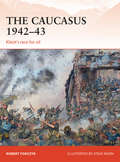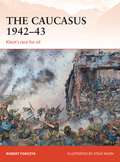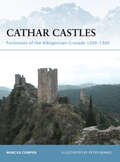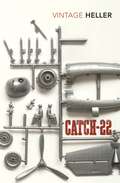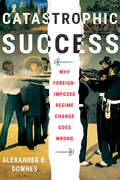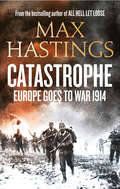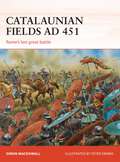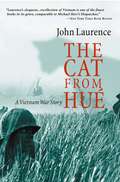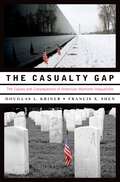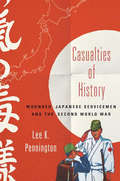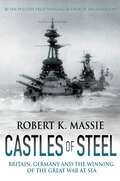- Table View
- List View
Causes, Course and Outcomes of World War Two (Histories and Controversies)
by John PlowrightIn the longer perspective, even the most momentous events can appear to lose coherence and significance. However, such was the impact of World War Two that even more than sixty years after its end, interest in the origins, course and consequences of the war continues to increase and generate debate.In this essential introductory guide, John Plowright casts a critical eye over the mass of literature that surrounds the conflict, focusing on key topics such as:- Nazi foreign policy and appeasement- the Fall of France- Operation Barbarossa and the Allied strategic bombing offensive- the impact of the war on Britain's international position and on American society- the movement towards European integration.This timely book provides an approachable synthesis of the scholarship relating to the causes, course and outcomes of the Second World War. It is ideal for all those in danger of drowning in the ocean of print on the subject and who wish to gain an understanding of the central issues and debates.
The Causes and Consequences of South Asia's Nuclear Tests (Adelphi series)
by Hilary SynnottWhy did India and Pakistan carry out nuclear tests in 1998 and what are the consequences of their actions? This paper examines the complex domestic and international factors that persuaded each country to drop its long-standing nuclear ambiguity. It also unravels the repercussions of the tests, both for regional stability and for global non-proliferation regimes, and argues that the West needs a new approach if it is to deal with the nuclear dangers on the subcontinent.
The Causes and Consequences of South Asia's Nuclear Tests (Adelphi series #No.332)
by Hilary SynnottWhy did India and Pakistan carry out nuclear tests in 1998 and what are the consequences of their actions? This paper examines the complex domestic and international factors that persuaded each country to drop its long-standing nuclear ambiguity. It also unravels the repercussions of the tests, both for regional stability and for global non-proliferation regimes, and argues that the West needs a new approach if it is to deal with the nuclear dangers on the subcontinent.
Cauldron of Resistance: Ngo Dinh Diem, the United States, and 1950s Southern Vietnam (The United States in the World)
by Jessica M. ChapmanIn 1955, Ngo Dinh Diem organized an election to depose chief-of-state Bao Dai, after which he proclaimed himself the first president of the newly created Republic of Vietnam. The United States sanctioned the results of this election, which was widely condemned as fraudulent, and provided substantial economic aid and advice to the RVN. Because of this, Diem is often viewed as a mere puppet of the United States, in service of its Cold War geopolitical strategy. That narrative, Jessica M. Chapman contends in Cauldron of Resistance, grossly oversimplifies the complexity of South Vietnam's domestic politics and, indeed, Diem's own political savvy. Based on extensive work in Vietnamese, French, and American archives, Chapman offers a detailed account of three crucial years, 1953–1956, during which a new Vietnamese political order was established in the south. It is, in large part, a history of Diem's political ascent as he managed to subdue the former Emperor Bao Dai, the armed Hoa Hao and Cao Dai religious organizations, and the Binh Xuyen crime organization. It is also an unparalleled account of these same outcast political powers, forces that would reemerge as destabilizing political and military actors in the late 1950s and early 1960s.Chapman shows Diem to be an engaged leader whose personalist ideology influenced his vision for the new South Vietnamese state, but also shaped the policies that would spell his demise. Washington's support for Diem because of his staunch anticommunism encouraged him to employ oppressive measures to suppress dissent, thereby contributing to the alienation of his constituency, and helped inspire the organized opposition to his government that would emerge by the late 1950s and eventually lead to the Vietnam War.
Caught, Back, Concluding
by Henry GreenDazzling, daring and full of original insight and wit, Henry Green offers a unique view of a class-ridden Britain enduring both war and its aftermath. In the apocalyptic atmosphere of the Blitz, so brilliantly evoked in Caught, gossip spreads like wildfire and the lives of two men are torn apart. In Back, Charley, an amputee, returns from a prison camp to his village and the grave of the woman he loved. Concluding was Green's own favourite of his novels and tells the story of a summer's day and a schoolgirl's disappearance.The text of Caught used in this edition is based on Green's original manuscript, which was censored by the publisher on first publication, but can be read now for the first time in unexpurgated form.
Caudine Forks 321 BC: Rome's Humiliation in the Second Samnite War (Campaign #322)
by Nic FieldsIn its long history, the Roman Republic suffered many defeats, but none as humiliating as the Caudine Forks in the summer of 321 BC. Rome had been at war with the Samnites – one of early Rome's most formidable foes – since 326 BC in what would turn out to be a long and bitter conflict now known as the Second Samnite War. The rising, rival Italic powers vied for supremacy in central and southern Italy, and their leaders were contemplating the conquest of the entire Italian peninsula. Driven by the ambitions of Titus Veturius Calvinus and Spurius Postumius Albinus, Roman forces were determined to inflict a crippling blow on the Samnites, but their combined armies were instead surprised, surrounded, and forced to surrender by the Samnites led by Gavius Pontius. The Roman soldiers, citizens of Rome to a man, were required to quit the field by passing under the yoke of spears in a humiliating ritual worse than death itself. This new study, using specially commissioned artwork and maps, analyses why the Romans were so comprehensively defeated at the Caudine Forks, and explains why the protracted aftermath of their dismal defeat was so humiliating and how it spurred them on to their eventual triumph over the Samnites. With this in mind, this study will widen its focus to take account of other major events in the Second Samnite War.
Caudine Forks 321 BC: Rome's Humiliation in the Second Samnite War (Campaign #322)
by Nic FieldsIn its long history, the Roman Republic suffered many defeats, but none as humiliating as the Caudine Forks in the summer of 321 BC. Rome had been at war with the Samnites – one of early Rome's most formidable foes – since 326 BC in what would turn out to be a long and bitter conflict now known as the Second Samnite War. The rising, rival Italic powers vied for supremacy in central and southern Italy, and their leaders were contemplating the conquest of the entire Italian peninsula. Driven by the ambitions of Titus Veturius Calvinus and Spurius Postumius Albinus, Roman forces were determined to inflict a crippling blow on the Samnites, but their combined armies were instead surprised, surrounded, and forced to surrender by the Samnites led by Gavius Pontius. The Roman soldiers, citizens of Rome to a man, were required to quit the field by passing under the yoke of spears in a humiliating ritual worse than death itself. This new study, using specially commissioned artwork and maps, analyses why the Romans were so comprehensively defeated at the Caudine Forks, and explains why the protracted aftermath of their dismal defeat was so humiliating and how it spurred them on to their eventual triumph over the Samnites. With this in mind, this study will widen its focus to take account of other major events in the Second Samnite War.
The Caucasus 1942–43: Kleist’s race for oil (Campaign)
by Robert Forczyk Mr Steve NoonMuch has been written of the titanic clashes between the Wehrmacht and the Red Army at Stalingrad, but this volume tells the other, equally important half of the story of Fall Blau (Case Blue). Learning from their experiences during the sweeping advances of Operation Barbarossa a year before, Wehrmacht commanders knew that Nazi Germany's lack of oil was a huge strategic problem. Seizure of the Caucasus oilfields, which were responsible for 82% of the Soviet Union's crude oil, would simultaneously alleviate the German army's oil shortages whilst denying vital fuel resources to the Red Army. Whilst Army Group B advanced along the Volga towards Stalingrad, Army Group A, spearheaded by Ewald von Kleist's elite Panzerarmee 1 was to advance into the Caucasus to seize the oilfields of Maikop, Grozny and Baku. Featuring full-colour artwork, archival photos and detailed analysis, this book follows the vicious, intense fighting that characterised one of the most important campaigns of World War II.
The Caucasus 1942–43: Kleist’s race for oil (Campaign)
by Robert Forczyk Steve NoonMuch has been written of the titanic clashes between the Wehrmacht and the Red Army at Stalingrad, but this volume tells the other, equally important half of the story of Fall Blau (Case Blue). Learning from their experiences during the sweeping advances of Operation Barbarossa a year before, Wehrmacht commanders knew that Nazi Germany's lack of oil was a huge strategic problem. Seizure of the Caucasus oilfields, which were responsible for 82% of the Soviet Union's crude oil, would simultaneously alleviate the German army's oil shortages whilst denying vital fuel resources to the Red Army. Whilst Army Group B advanced along the Volga towards Stalingrad, Army Group A, spearheaded by Ewald von Kleist's elite Panzerarmee 1 was to advance into the Caucasus to seize the oilfields of Maikop, Grozny and Baku. Featuring full-colour artwork, archival photos and detailed analysis, this book follows the vicious, intense fighting that characterised one of the most important campaigns of World War II.
The Catonsville Nine: A Story of Faith and Resistance in the Vietnam Era
by Shawn Francis PetersIn the spring of 1968, a group of Catholic antiwar activists barged into a draft board in suburban Baltimore, stole hundreds of Selective Service records, and burned the documents in a fire fueled by homemade napalm. The bold actions of the ''Catonsville Nine'' quickly became international news, and they remained in the headlines throughout the summer and fall of 1968, when the activists were tried in federal court. Shawn Francis Peters tells the fascinating story of this singular witness for peace and social justice.
Cathar Castles: Fortresses of the Albigensian Crusade 1209–1300 (Fortress #55)
by Marcus CowperDuring the early 13th century the north of what is now France went to war with the south in a bloody crusade aimed at destroying the heretical sect known as the Cathars. The conflict was characterized by vicious guerrilla actions and the besieging of the innumerable fortified sites that dotted the landscape of the south. Illustrated with full colour artwork and stunning photographs, this book describes the castles and fortifications of the Cathar period, examining their design, construction and the role that they played during the Albigensian Crusade.
Cathar Castles: Fortresses of the Albigensian Crusade 1209–1300 (Fortress)
by Peter Dennis Marcus CowperDuring the early 13th century the north of what is now France went to war with the south in a bloody crusade aimed at destroying the heretical sect known as the Cathars. The conflict was characterized by vicious guerrilla actions and the besieging of the innumerable fortified sites that dotted the landscape of the south. Illustrated with full colour artwork and stunning photographs, this book describes the castles and fortifications of the Cathar period, examining their design, construction and the role that they played during the Albigensian Crusade.
Catch My Breath (The Breathless Series #1)
by Lynn MontaganoLia Meyers' plan for a relaxing Scottish vacation is short-lived when one uncharacteristic moment of clumsiness lands her in the arms of her very own Knight in Shining Armani…
Catch-22: As recommended on BBC2’s Between the Covers (Le\livre De Poche Ser.)
by Joseph Heller**AS SEEN ON BBC TWO's BETWEEN THE COVERS**Discover Joseph Heller's hilarious and tragic satire on military madness, and the tale of one man's efforts to survive it.It's the closing months of World War II and Yossarian has never been closer to death. Stationed in an American bomber squadron off the coast of Italy, each flight mission introduces him to thousands of people determined to kill him.But the enemy above is not Yossarian's problem - it is his own army intent on keeping him airborne, and the maddening 'Catch-22' that allows for no possibility of escape.'The greatest satirical work in the English language' Observer
Catastrophic Success: Why Foreign-Imposed Regime Change Goes Wrong (Cornell Studies in Security Affairs)
by Alexander B. DownesIn Catastrophic Success, Alexander B. Downes compiles all instances of regime change around the world over the past two centuries. Drawing on this impressive data set, Downes shows that regime change increases the likelihood of civil war and violent leader removal in target states and fails to reduce the probability of conflict between intervening states and their targets. As Downes demonstrates, when a state confronts an obstinate or dangerous adversary, the lure of toppling its government and establishing a friendly administration is strong. The historical record, however, shows that foreign-imposed regime change is, in the long term, neither cheap, easy, nor consistently successful. The strategic impulse to forcibly oust antagonistic or non-compliant regimes overlooks two key facts. First, the act of overthrowing a foreign government sometimes causes its military to disintegrate, sending thousands of armed men into the countryside where they often wage an insurgency against the intervener. Second, externally-imposed leaders face a domestic audience in addition to an external one, and the two typically want different things. These divergent preferences place imposed leaders in a quandary: taking actions that please one invariably alienates the other. Regime change thus drives a wedge between external patrons and their domestic protégés or between protégés and their people. Catastrophic Success provides sober counsel for leaders and diplomats. Regime change may appear an expeditious solution, but states are usually better off relying on other tools of influence, such as diplomacy. Regime change, Downes urges, should be reserved for exceptional cases. Interveners must recognize that, absent a rare set of promising preconditions, regime change often instigates a new period of uncertainty and conflict that impedes their interests from being realized.
Catastrophe: Europe Goes To War
by Max HastingsA magisterial chronicle of the calamity that crippled Europe in 1914.
Catalaunian Fields AD 451: Rome’s last great battle (Campaign #286)
by Peter Dennis Simon MacDowallThe battle of the Catalaunian Fields saw two massive, powerful empires square up in a conflict that was to shape the course of Eurasian history forever. For despite the Roman victory, the Roman Empire would not survive for more than 15 years following the battle, whilst the Huns, shattered and demoralized, would meet their downfall against a coalition of German tribes soon after. This book, using revealing bird's-eye-views of the plains of Champagne and detailed illustrations of the opposing warriors in the midst of desperate combat, describes the fighting at the Catalaunian Fields and reveals the broader campaign of Hunnic incursion that led up to it. Drawing on the latest research, Simon MacDowall reveals the shocking intensity and appalling casualties of the battle, whilst assessing the wider significance and consequences of the campaign.
Catalaunian Fields AD 451: Rome’s last great battle (Campaign #286)
by Peter Dennis Simon MacDowallThe battle of the Catalaunian Fields saw two massive, powerful empires square up in a conflict that was to shape the course of Eurasian history forever. For despite the Roman victory, the Roman Empire would not survive for more than 15 years following the battle, whilst the Huns, shattered and demoralized, would meet their downfall against a coalition of German tribes soon after. This book, using revealing bird's-eye-views of the plains of Champagne and detailed illustrations of the opposing warriors in the midst of desperate combat, describes the fighting at the Catalaunian Fields and reveals the broader campaign of Hunnic incursion that led up to it. Drawing on the latest research, Simon MacDowall reveals the shocking intensity and appalling casualties of the battle, whilst assessing the wider significance and consequences of the campaign.
The Cat From Hue: A Vietnam War Story
by John LaurenceWinner of the Overseas Press Club Cornelius Ryan AwardJohn Laurence covered the Vietnam war for CBS News from its early days, through the bloody battle of Hue in 1968, to the Cambodian invasion. He was judged by his colleagues to be the best television reporter of the war, however, the traumatic stories Laurence covered became a personal burden that he carried long after the war was over.In this evocative, unflinching memoir, laced with humor, anger, love, and the unforgettable story of Méo, a cat rescued from the battle of Hue, Laurence recalls coming of age during the war years as a journalist and as a man. Along the way, he clarifies the murky history of the war and the role that journalists played in altering its course.The Cat from Hué has earned passionate acclaim from many of the most renowned journalists and writers about the war, as well as from military officers and war veterans, book reviewers, and readers. This book will stand with Michael Herr's Dispatches, Philip Caputo's A Rumor of War, and Neil Sheehan's A Bright, Shining Lie as one of the best books ever written about Vietnam-and about war generally.
The Cat From Hue: A Vietnam War Story
by John LaurenceWinner of the Overseas Press Club Cornelius Ryan Award John Laurence covered the Vietnam war for CBS News from its early days, through the bloody battle of Hue in 1968, to the Cambodian invasion. He was judged by his colleagues to be the best television reporter of the war, however, the traumatic stories Laurence covered became a personal burden that he carried long after the war was over. In this evocative, unflinching memoir, laced with humor, anger, love, and the unforgettable story of Mé a cat rescued from the battle of Hue, Laurence recalls coming of age during the war years as a journalist and as a man. Along the way, he clarifies the murky history of the war and the role that journalists played in altering its course.The Cat from Huéi> has earned passionate acclaim from many of the most renowned journalists and writers about the war, as well as from military officers and war veterans, book reviewers, and readers. This book will stand with Michael Herr's Dispatches, Philip Caputo's A Rumor of War, and Neil Sheehan's A Bright, Shining Lie as one of the best books ever written about Vietnam-and about war generally.
The Casualty Gap: The Causes and Consequences of American Wartime Inequalities
by Douglas L. Kriner Francis X. ShenThe Casualty Gap shows how the most important cost of American military campaigns--the loss of human life--has been paid disproportionately by poorer and less-educated communities since the 1950s. Drawing on a rich array of evidence, including National Archives data on the hometowns of more than 400,000 American soldiers killed in World War II, Korea, Vietnam, and Iraq, this book is the most ambitious inquiry to date into the distribution of American wartime casualties across the nation, the forces causing such inequalities to emerge, and their consequences for politics and democratic governance.
The Casualty Gap: The Causes and Consequences of American Wartime Inequalities
by Douglas L. Kriner Francis X. ShenThe Casualty Gap shows how the most important cost of American military campaigns--the loss of human life--has been paid disproportionately by poorer and less-educated communities since the 1950s. Drawing on a rich array of evidence, including National Archives data on the hometowns of more than 400,000 American soldiers killed in World War II, Korea, Vietnam, and Iraq, this book is the most ambitious inquiry to date into the distribution of American wartime casualties across the nation, the forces causing such inequalities to emerge, and their consequences for politics and democratic governance.
Casualties of the New World Order: The Causes of Failure of UN Missions to Civil Wars
by M. WesleyCasualties of the New World Order contends that the high rate of failure among post-Cold War UN missions are attributable to common weaknesses which are vulnerable to civil war dynamics. These mission weaknesses derive from the high level of control over the missions' mandates and operations wielded by combinations of self-interested and distracted UN member-states. The effects of these weaknesses are examined in the failed missions in Bosnia, Somalia, and Angola, while their absence is observed in the successful missions to El Salvador, Mozambique, and Cambodia.
Casualties of History: Wounded Japanese Servicemen and the Second World War (Studies of the Weatherhead East Asian Institute, Columbia University)
by Lee K. PenningtonThousands of wounded servicemen returned to Japan following the escalation of Japanese military aggression in China in July 1937. Tens of thousands would return home after Japan widened its war effort in 1939. In Casualties of History, Lee K. Pennington relates for the first time in English the experiences of Japanese wounded soldiers and disabled veterans of Japan’s "long" Second World War (from 1937 to 1945). He maps the terrain of Japanese military medicine and social welfare practices and establishes the similarities and differences that existed between Japanese and Western physical, occupational, and spiritual rehabilitation programs for war-wounded servicemen, notably amputees. To exemplify the experience of these wounded soldiers, Pennington draws on the memoir of a Japanese soldier who describes in gripping detail his medical evacuation from a casualty clearing station on the front lines and his medical convalescence at a military hospital. Moving from the hospital to the home front, Pennington documents the prominent roles adopted by disabled veterans in mobilization campaigns designed to rally popular support for the war effort. Following Japan’s defeat in August 1945, U.S. Occupation forces dismantled the social welfare services designed specifically for disabled military personnel, which brought profound consequences for veterans and their dependents. Using a wide array of written and visual historical sources, Pennington tells a tale that until now has been neglected by English-language scholarship on Japanese society. He gives us a uniquely Japanese version of the all-too-familiar story of soldiers who return home to find their lives (and bodies) remade by combat.
Castles of Steel: Britain, Germany and the Winning of the Great War at Sea
by Robert K. MassieOn the eve of the war in August 1914, Great Britain and Germany possessed the two greatest navies the world had ever seen: two fleets of dreadnoughts – gigantic 'castles of steel' able to hurl massive shells at an enemy miles away – were ready to test their terrible power against each other.They skirmished across the globe before Germany, suffocated by an implacable naval blockade, decided to definitively strike against the British ring of steel. The result was Jutland, a titanic clash of fifty-eight dreadnoughts, each holding of a thousand men. When the German High Seas Fleet retreated, the Kaiser unleashed unrestricted U-boat warfare, which, in its indiscriminate violence, brought a reluctant America into the war: the German effort to "seize the trident" led to the fall of the German empire. Massie's portrayals of Winston Churchill, the British admirals Fisher, Jellicoe, and Beatty, and the Germans Scheer, Hipper, and Tirpitz are stunning in their veracity and artistry.

